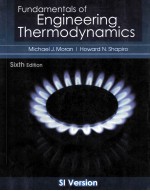图书介绍
Fundamentals of Engineering Thermodynamicspdf电子书版本下载

- Michael J.Moran 著
- 出版社: John Wiley & Sons(Asia)pte Ltd
- ISBN:
- 出版时间:2010
- 标注页数:727页
- 文件大小:169MB
- 文件页数:739页
- 主题词:
PDF下载
下载说明
Fundamentals of Engineering ThermodynamicsPDF格式电子书版下载
下载的文件为RAR压缩包。需要使用解压软件进行解压得到PDF格式图书。建议使用BT下载工具Free Download Manager进行下载,简称FDM(免费,没有广告,支持多平台)。本站资源全部打包为BT种子。所以需要使用专业的BT下载软件进行下载。如 BitComet qBittorrent uTorrent等BT下载工具。迅雷目前由于本站不是热门资源。不推荐使用!后期资源热门了。安装了迅雷也可以迅雷进行下载!
(文件页数 要大于 标注页数,上中下等多册电子书除外)
注意:本站所有压缩包均有解压码: 点击下载压缩包解压工具
图书目录
CHAPTER 1 Getting Started: Introductory Concepts and Definitions 1
1.1 Using Thermodynamics 1
1.2 Defining Systems 1
1.3 Describing Systems and Their Behavior 4
1.4 Measuring Mass, Length, Time, and Force 8
1.5 Two Measurable Properties: Specific Volume and Pressure 10
1.6 Measuring Temperature 14
1.7 Engineering Design and Analysis 18
Chapter Summary and Study Guide 22
CHAPTER 2 Energy and the First Law of Thermodynamics 29
2.1 Reviewing Mechanical Concepts of Energy 29
2.2 Broading Our Understanding of Work 33
2.3 Broading Our Understanding of Energy 43
2.4 Energy Transfer By Heat 44
2.5 Energy Accounting: Energy Balance for Closed Systems 48
2.6 Energy Analysis of Cycles 58 Chapter Summary and Study Guide 62
CHAPTER 3 Evaluating Properties 69
3.1 Fixing the State 69
EVALUATING PROPERTIES: GENERAL CONSIDERATIONS 70
3.2 ρ-v-T Relation 70
3.3 Retrieving Thermodynamic Properties 76
3.4 Generalized Compressibility Chart 94
EVALUATING PROPERTIES USING THE IDEAL GAS MODEL 100
3.5 Ideal Gas Model 100
3.6 Internal Energy, Enthalpy, and Specific Heats of Ideal Gases 103
3.7 Evaluating??u and??h using Ideal Gas Tables, Software, and Constant Specific Heats 105
3.8 Polytropic Process of an Ideal Gas 112
Chapter Summary and Study Guide 114
CHAPTER 4 Control Volume Analysis Using Energy 121
4.1 Conservation of Mass for a Control Volume 121
4.2 Conservation of Energy for a Control Volume 128
4.3 Analyzing Control Volumes at Steady State 131
4.4 Transient Analysis 152
Chapter Summary and Study Guide 162
CHAPTER 5 The Second Law of Thermodynamics 174
5.1 Introducing the Second Law 174
5.2 Identifying Irreversibilities 180
5.3 Applying the Second Law to Thermodynamic Cycles 184
5.4 Defining the Kelvin Temperature Scale 190
5.5 Maximum Performance Measures for Cycles Operating Between Two Reservoirs 192
5.6 Carnot Cycle 196
Chapter Summary and Study Guide 199
CHAPTER 6 Using Entropy 206
6.1 Introducing Entropy 206
6.2 Defining Entropy Change 208
6.3 Retrieving Entropy Data 209
6.4 Entropy Change in Internally Reversible Processes 217
6.5 Entropy Balance for Closed Systems 220
6.6 Entropy Rate Balance for Control Volumes 231
6.7 Isentropic Processes 240
6.8 Isentropic Efficiencies of Turbines, Nozzles, Compressors, and Pumps 246
6.9 Heat Transfer and Work in Internally Reversible, Steady-State Flow Processes 254
Chapter Summary and Study Guide 257
CHAPTER 7 Exergy Analysis 272
7.1 Introducing Exergy 272
7.2 Defining Exergy 273
7.3 Closed System Exergy Balance 283
7.4 Flow Exergy 290
7.5 Exergy Rate Balance for Control Volumes 293
7.6 Exergetic (Second Law) Efficiency 303
7.7 Thermoeconomics 309
Chapter Summary and Study Guide 315
CHAPTER 8 Vapor Power Systems 325
8.1 Modeling Vapor Power Systems 325
8.2 Analyzing Vapor Power Systems--Rankline Cycle 327
8.3 Improving Performance--Superheat and Reheat 340
8.4 Improving Performance--Regenerative Vapor Power Cycle 346
8.5 Other Vapor Cycle Aspects 356
8.6 Case Study: Exergy Accounting of a Vapor Power Plant 358
Chapter Summary and Study Guide 365
CHAPTER 9 Gas Power Systems 373
INTERNAL COMBUSTION ENGINES 373
9.1 Introducing Engine Terminology 373
9.2 Air-Standard Otto Cycle 375
9.3 Air-Standard Diesel Cycle 381
9.4 Air-Standard Dual Cycle 385
GAS TURBINE POWER PLANTS 388
9.5 Modeling Gas Turbine Power Plants 388
9.6 Air-Standard Brayton Cycle 389
9.7 Regenerative Gas Turbines 399
9.8 Regenerative Gas Turbines with Reheat and Intercooling 404
9.9 Gas Turbines for Aircraft Propulsion 414
9.10 Combined Gas Turbine--Vapor Power Cycle 419
9.11 Ericsson and Stirling Cycles 424
COMPRESSIBLE FLOW THROUGH NOZZLES AND DIFFUSERS 426
9.12 Compressible Flow Preliminaries 426
9.13 Analyzing One-Dimensional Steady Flow in Nozzles and Diffusers 430
9.14 Flow in Nozzles and Diffusers of Ideal Gases with Constant Specific Heats 436
Chapter Summary and Study Guide 444
CHAPTER 10 Refrigeration and Heat Pump Systems 454
10.1 Vapor Refrigeration Systems 454
10.2 Analyzing Vapor-Compression Refrigeration Systems 457
10.3 Refrigerant Properties 465
10.4 Cascade and Multistage Vapor-Compression Systems 467
10.5 Absorption Refrigeration 469
10.6 Heat Pump Systems 471
10.7 Gas Refrigeration Systems 473
Chapter Summary and Study Guide 479
CHAPTER 11 Thermodynamic Relations 487
11.1 Using Equations of State 487
11.2 Important Mathematical Relations 494
11.3 Developing Property Relations 497
11.4 Evaluating Changes in Entropy, Internal Energy,and Enthalpy 504
11.5 Other Thermodynamic Relations 513
11.6 Constructing Tables of Thermodynamic Properties 520
11.7 Generalized Charts for Enthalpy and Entropy 524
11.8 p-v-T Relations for Gas Mixtures 531
11.9 Analyzing Multicomponent Systems 536
Chapter Summary and Study Guide 548
CHAPTER 12 Ideal Gas Mixtures and Psychrometrics Applications 558
IDEAL GAS MIXTURES: GENERAL CONSIDERATIONS 558
12.1 Describing Mixture Composition 558
12.2 Relating p, V, and T for Ideal Gas Mixtures 562
12.3 Evaluating U, H, Sand Specific Heats 564
12.4 Analyzing Systems Involving Mixtures 566
PSYCHROMETRIC APPLICATIONS 579
12.5 Introducing Psychrometric Principles 579
12.6 Psychrometers: Measuring the Wet-Bulb and Dry-Bulb Temperatures 590
12.7 Psychrometric Charts 592
12.8 Analyzing Air-Conditioning Processes 593
12.9 Cooling Towers 609
Chapter Summary and Study Guide 611
CHAPTER 13 Reacting Mixtures and Combustion 620
COMBUSTION FUNDAMENTALS 620
13.1 Introducing Combustion 620
13.2 Conservation of Energy--Reacting Systems 629
13.3 Determining the Adiabatic Flame Temperature 641
13.4 Fuel Cells 645
13.5 Absolute Entropy and the Third Law of Thermodynamics 648
CHEMICAL EXERGY 655
13.6 Introducing Chemical Exergy 655
13.7 Standard Chemical Exergy 659
13.8 Exergy Summary 664
13.9 Exergetic (Second Law) Efficiencies of Reacting Systems 667
Chapter Summary and Study Guide 669
CHAPTER 14 Chemical and Phase Equilibrium 679
EQUILIBRIUM FUNDAMENTALS 679
14.1 Introducing Equilibrium Criteria 679
CHEMICAL EQUILIBRIUM 684
14.2 Equation of Reaction Equilibrium 684
14.3 Calculating Equilibrium Compositions 686
14.4 Further Examples of the Use of the Equilibrium Constant 695
PHASE EQUILIBRIUM 704
14.5 Equilibrium Between Two Phases of a Pure Substance 705
14.6 Equilibrium of Multicomponent, Multiphase Systems 706
Chapter Summary and Study Guide 711
Index 719